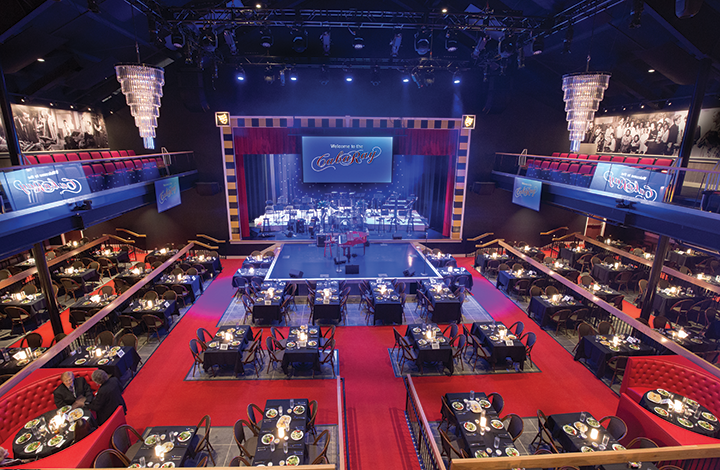Equipment List
Nashville TN has long winked at its alternative sobriquet, “NashVegas,” which suggests there’s more underneath the covers than the rapidly growing metropolis’ tourist-friendly “Music City” moniker would imply. In fact, beyond watching the bachelorette parties it famously attracts get blotto on the Lower Broadway strip of clubs, Nashville’s nightlife is actually a bit tame. “We have great daytime attractions for the tour market, but we don’t have a lot of evening entertainment offerings, once you get past the Opry,” Nashville Convention and Visitors Corp. CEO Butch Spyridon told the Nashville Ledger last year.
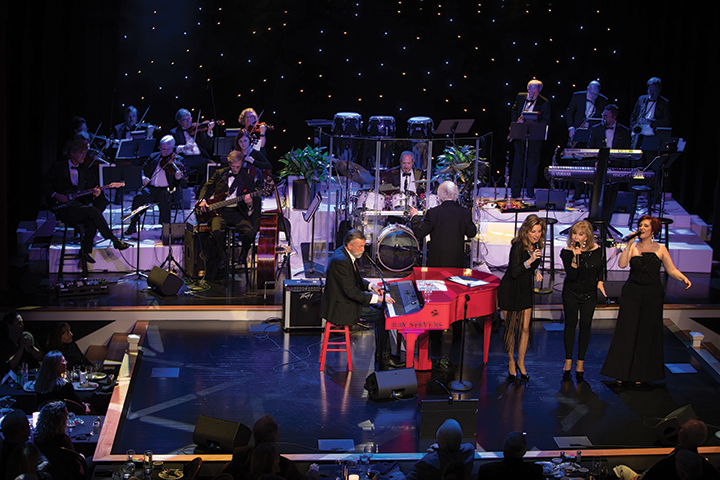
Ray Stevens wanted to change that. The ageless, Grammy-winning country star, best known for 1970s comedy cuts like “Ahab The Arab,” “Gitarzan” and “The Streak,” but who also created pop classics like “Everything Is Beautiful,” which have sold more than 40 million records, has, at the age of 79, opened a true Nashville-Las Vegas NV hybrid. Ray Stevens’ CabaRay is a Vegas-style dinner-theater showroom, complete with piano lounge, premium dining and beverage service, and a gift shop. However, the 35,000-square-foot, custom-built structure, set atop a hill he had trimmed on Nashville’s west side, also includes a recording studio and television production facilities.
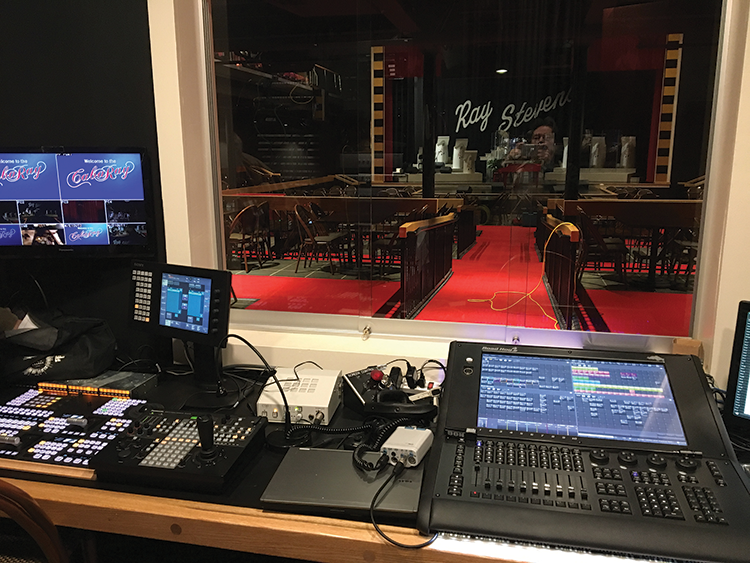
CabaRay seats 500 on the dinner floor, with 200 more raked theater seats surrounding the floor in a three-sided balcony that doubles as a gallery, featuring blow-ups of historic photographs that chart the intertwined histories of Nashville’s recording studios, country music and Stevens himself. The venue’s broad hallway is lined with display cases filled with memorabilia—guitars, awards and costumes—from that same combination of legacies. All of them are well curated, considering this is not one of the number of museums dedicated to country icons like Johnny Cash and George Jones that have opened locally in recent years.
CabaRay is, as Stevens himself might say, a regular joint where you can be entertained and edified for the price of a single ticket.
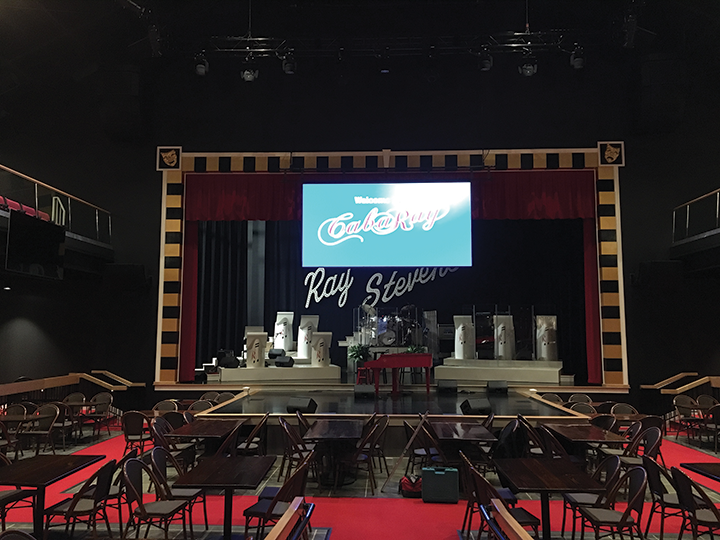 CabaRay opened on January 18, nearly two years after Stevens commissioned work on a hilltop overlooking I-40 and a Walmart (you’re not coming here for the view). The AV systems integration approach to the venue could be called component based. The project was accomplished by a team of local subcontractors and vendors, such as Bandit Lites, which installed the venue’s theatrical lighting system, including a High End Systems RoadHog4 console; Mankin Media Systems, which supplied the lion’s share of the video production equipment; Marshall Graphics, which provided the Avid S6L FOH console; and 4D Systems, which performed the majority of the cabling and termination within the facility.
CabaRay opened on January 18, nearly two years after Stevens commissioned work on a hilltop overlooking I-40 and a Walmart (you’re not coming here for the view). The AV systems integration approach to the venue could be called component based. The project was accomplished by a team of local subcontractors and vendors, such as Bandit Lites, which installed the venue’s theatrical lighting system, including a High End Systems RoadHog4 console; Mankin Media Systems, which supplied the lion’s share of the video production equipment; Marshall Graphics, which provided the Avid S6L FOH console; and 4D Systems, which performed the majority of the cabling and termination within the facility.
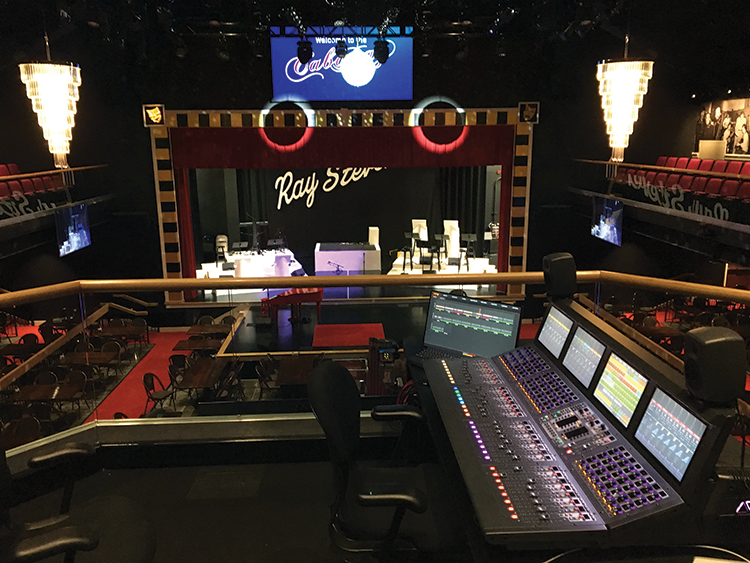
The entire project was designed and supervised by Shipley Landiss, a longtime fixture in Nashville’s AV and broadcast businesses, who oversaw the original AV renovations at the Ryman Auditorium and the building of the Wildhorse Saloon, the city’s first major-league music club venue. TNN, the forerunner to CMT, and now known as Heartland, brought Landiss and associates aboard in the 1990s, both to buttress its NASCAR broadcast racing operations and to design and outfit its NASCAR Thunder retail chain, where audio and video were used to create a connection for consumers between the store experience and the network’s content.
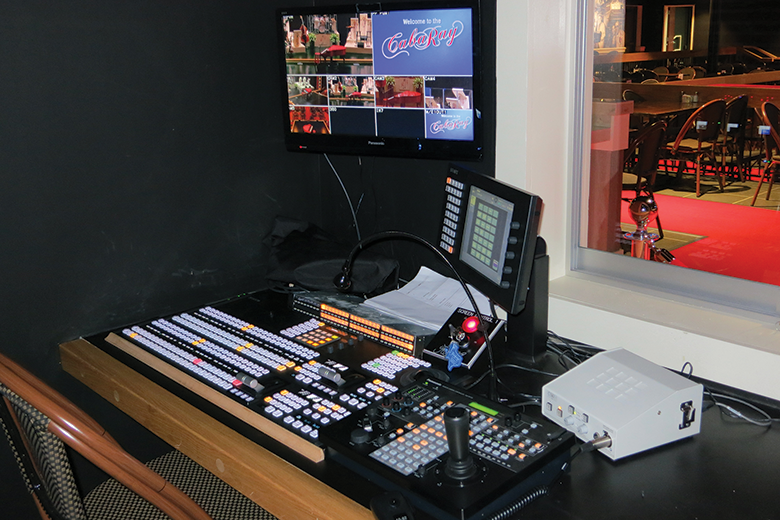
“Ray is very creative, and he’s all about creating an experience for the audience, too—not just a show,” Landiss explained. “Having a group of subcontractors that have worked with each other before, and that know what each other can bring to the table, allowed us to give Ray what he wanted, as well as being able to respond to changing project needs as they arose.”
The Sound Of Music
Steven Durr Designs, LLC, the audio and acoustical consultant on the project, was also involved from the very beginning. That began with Durr roaming the newly clipped hilltop more than a year ago with a disembodied humbucker guitar pickup attached to a battery-powered amplifier—a primitive, but highly effective, way to scan the intended site of the venue for electro-magnetic interference (EMI) from nearby TVA high-voltage power lines. It was, he said, the same way a guitar player on stage would discover such interference—just not unexpectedly, in the middle of a set.
“I wanted to know what we were in for in terms of possible EMI and RF interference in the area,” Durr said. Vetting for EMI and RF was especially important because the building would be of prefabricated, all-metal construction. “As it turned out, it wasn’t anything that we couldn’t manage,” he added. “We didn’t need, like, a Faraday cage around the place. All we had to do was make sure the all-metal building was well grounded with ground rods deep into the concrete slab they were going to pour.” The ability to assure proper grounding, he added, is one of the main benefits of a ground-up build project of any type. “It’s so much better to know what you’re getting into than to have to try to fix it after the fact,” he stated.
The sound system specified for the venue was a Bose RoomMatch. Durr, who used a similar system concept when he designed the sound for the new Austin City Limits (ACL) Live/Moody Theater venue in 2011, said the point of a musical sound system is not to be heard. “No one goes to a club or a theater to hear the sound system,” he said. “They come to hear the music and have an emotional connection with the artist. So, you want to design it in such a way that the PA system is invisible.”
Individual loudspeaker enclosures were chosen based on each module’s waveguide patterns. RoomMatch enclosures come with pre-set dispersion patterns, so Durr could use a combination of symmetrical and asymmetrical patterned boxes to ensure complete coverage. Each side of the main stereo PA system uses one RMS218 subwoofer on top of one RM9040 and an asymmetrical RM286040 in an array at the top of the proscenium wall, and an asymmetrical RM602840 lower down the wall at the balcony rail level; the orientation of the asymmetrical cabinets is reversed from one side to the other. There are two RMS215 subwoofers beneath the stage thrust. The main room sound system is powered by four PowerMatch PM8500N networked amplifiers, two per house side.
Harder-to-reach areas, such as under the balconies and at the rear of the galleries, use a total of 12 RoomMatch Utility RMU208 speakers as fills and delays, with four smaller 12-inch MB12 subwoofers used under the rear balcony seats. The RMU208 delay loudspeakers are powered by two PowerMatch PM8500 amplifiers—one for left and right. The MB12 subs are powered by two PM4500N networked amplifiers. In addition, Bose FreeSpace DS100F in-ceiling speakers are used in the hallways, the foyer/box office area, and the restrooms, powered by another PM8500N amplifier, to extend the live performance to those parts of the venue. These are proportionally delayed, using two Bose Professional ControlSpace ESP-4120 engineered sound processors. Minimal additional processing is from a pair of White Instruments 4400 1/3-octave broadband equalizers from Durr’s personal stash of these sought-after vintage EQs, which he integrates into most of his projects.
“The point,” Durr explained, “was to maintain the same tonality throughout the venue, which we are able to do by using the same brand of speakers throughout, and to keep the timing consistent, so that, when you move from one part of the building to another, the music stays with you. The music experience isn’t limited to the main room—it’s the same everywhere.”
The performance space also required careful architectural-acoustic design. It’s made up of parallel surfaces, broken up and naturally diffused to an extent by the balcony that surrounds most of it. However, the building’s metal roof could resonate from heavy rains, so Durr specified spray-on acoustical material, which helps deaden exterior noise, while also reducing interior reflections. But the main acoustical tactic was the inclusion of 30 complex hanging clouds, suspended at a 45-degree angle from the ceiling and facing into the audience space. Each one is custom made, consisting of thin, perforated metal on the side that faces the room, letting a fixed percentage of the sound pass through to absorptive backing material on its reverse side. The size and number of perforations determines how much sound is attenuated, at what frequencies, and how much is reflected back into the room, helping to create sufficient ambience and liveliness.
“That’s something Ray really wants,” according to Durr, who did the acoustics for Stevens’ two recording studios on Nashville’s Music Row, and who worked on Stevens’ short-lived Branson MO theater in the 1990s. “He needs to hear the room and how he sounds in the room, and he likes things bigger than life. You can’t get that from monitors alone; you need to have some of the energy kept in the room.” The combination of acoustical materials and properly internally dampened HVAC ducts resulted in a room noise rating of NC20…about what you’d want in a recording studio, Durr noted.
The prefabricated building presented one more challenge for sound—it wasn’t designed to support several hundred pounds of line arrays hanging from its ceiling or rafters. The solution was to fabricate custom steel frames—two per side on either side of the proscenium—that are bolted to the interior of the building and also rooted in the slab. That is what the 1,500lb. arrays are attached to. An outside engineering firm made the frames, with input from the architect, the general contractor and Bose engineers. “That was Shipley’s idea,” Durr remarked. “Otherwise, the concern was that the PA could shear off of the wall if we attached it to that.”
The live sound is managed by an Avid S6L front-of-house console perched on an extension of the rear balcony. The console is installed in a side-loaded configuration, to minimize sightline problems for seats directly behind it. Careful attention was also paid to ensuring that the entire digital portion of the audio system was synced to an external word clock (derived from the video system reference), which Durr said is critical for sonic quality.
No Vegas venue would be complete without a piano bar, and CabaRay has one that keeps with its dual mission of being an entertainment venue and an attraction. A semicircular bar is overlooked by a massive portrait of legendary country music publisher and record producer Bill Lowery, for whom the High Spirits Emporium piano bar is named, and who gave Stevens his start in the business in 1956 as a songwriter. It has its own sound, using two self-powered Mackie TH15s that are attached to the walls, along with an Allen & Heath Z12 mixer.
Putting On The Show
CabaRay’s secret weapons are its television and recording capabilities. The stage is covered by five nearly invisible Panasonic HE-130 HD PTZ cameras—four are mounted to the balcony supports in front of, and to each side of, the stage; a fifth is mounted to a backstage lighting truss to provide both overhead shots of musicians and reverse-angle shots of the audience. Feeds from these cameras are available for use by video productions occurring at CabaRay, as well. (During the second week of February, Stevens was able to begin shooting episodes for his television show “Ray Stevens’ CabaRay Nashville,” which airs on PBS, from the new venue using a rented remote video production truck.)
In the main room, five 82-inch Samsung displays are mounted from the balcony rims, two per side, and they’re generally fed image magnification (IMAG) content from the stage through the video switcher during live shows. “The point of that was to assure that every seat in the house is a great seat, even if it’s under the balcony,” Landiss said. The big video focus, though, is the 6.5’x13′, 3mm videowall—configured in landscape and made by SquareV, a locally based LED videowall manufacturer—that is raised and lowered from above the proscenium in front of the curtain valence. “Ray has a few songs that include video content, which plays back during the live performance,” Landiss explained. “This way, the screen is in and out as needed, and it doesn’t disrupt the rest of the stage.”
The recording studio, still under construction at press time, is in an adjacent area, connected to the main performance area and the video control room with 114 split tie lines. Again, Durr said, the benefits of ground-up construction were really felt here, with its floor slabs separated from the main building for sound isolation, and cabling being made simpler by being run directly. All of the in-use cables are a combination of copper and coaxial—the proximity of the production and eventual control areas will be close enough not to necessitate fiber. However, according to Landiss, the house is also strung with single-mode fiber in anticipation of more complex live productions in the future. Tie lines are already in place to let the venue switch over seamlessly and quickly when the time comes to use the in-house production facilities.
There is also some AV networking already in place. For instance, Dante has been implemented for signal transport and control of the Shure Axient Digital wireless microphone system, as well as for the Bose DSP system control. The Avid S6L FOH console uses native AVB to connect its work surface, processing and runs to its stage boxes.
With CabaRay, Nashville is getting the broadly appealing nighttime music club venue that its tourism architect said it needed. The fact that it came to be thanks to one of the classic stars who made Nashville the music mecca it’s become is just the icing on the cake. And knowing Ray Stevens, it’ll be good cake.
EQUIPMENT
Showroom Audio
6 Audio Accessories 2390W 96-Point TT patchbays
1 Avid VENUE S6L-32D-144 digital audio console
3 Bose ControlSpace ESP-4120 engineered sound processors
4 Bose MB12 12″ modular bass speakers
2 Bose PowerMatch PM4500N 4-channel power amps
5 Bose PowerMatch PM8500N 8-channel power amps
2 Bose RoomMatch RM286040 asymmetrical 40° vertical modules
2 Bose RoomMatch RM602840 asymmetrical 40° vertical modules
2 Bose RoomMatch RM9040 symmetrical 40° vertical modules
2 Bose RoomMatch RMS215 subwoofer modules
2 Bose RoomMatch RMS218 VLF-subwoofers
4 Bose RoomMatch Utility RMU105 ultra-compact foreground/fill speakers
12 Bose RoomMatch Utility RMU208 small-format sound reinforcement speakers
4 Earthworks FW730 FlexWand integrated cardioid mics, booms and stands
1 Earthworks PM40 PianoMic piano mic system
3 L-Acoustics LA4X 4-channel power amps
13 L-Acoustics X8 live monitor enclosures
Middle Atlantic rackmount shelves and hardware
5 Middle Atlantic WRK-44-32 equipment racks
2 Oxmoor MDA-26T distribution amps
1 Oxmoor RMX-44 mixing matrix
Penn Elcom rackmount shelves, connectors, blanks and vented rack panels
120 Redco 24″ TT patchcords
1 Rosendahl Studiotechnik nanosyncs HD multistandard sync engine
2 RTS 416 1×6 audio distribution amps
2 Shure Axient Digital AD1 bodypack transmitters
10 Shure Axient Digital AD2/K8B handheld wireless mic transmitters
5 Shure Axient Digital AD4D 2-channel digital wireless receivers
1 Shure UA845UWB ultra-wideband antenna distribution system
2 Shure UA874US active directional UHF antennas w/gain switches
1 Whirlwind custom monitor speaker patch panel (12 amp channels
to 36 stage locations)
8 Whirlwind SPC83 8-channel, 3-way, transformer isolated mic splitters
2 White Instruments Model 4400 L-C active 1/3 octave graphic equalizers
Piano Bar Audio
1 Allen & Heath ZED-12FX multipurpose mixer w/FX
2 Mackie Thump TH-15A 15″ active speakers
1 Sennheiser MD835 dynamic cardioid mic capsule
1 Shure BLX2/SM58 handheld wireless mic transmitter
1 White Instruments Model 4700-2 R-C active 1/3 octave, digitally controlled graphic equalizer
Background Audio
3 Bose ControlCenter CC-2 zone controllers
26 Bose FreeSpace DS 100F flush-mount speakers
23 Bose FreeSpace DS 16S surface-mount speakers
1 Bose FreeSpace DS 40F flush-mount speaker
3 Bose FreeSpace DXA 2120 digital mixers/amps
1 Bose PowerMatch PM8500N power amp
1 Shure BLX2/SM58 handheld wireless mic transmitter
Showroom Video
32 ADC BK2V-STM black hi-def video patch cables (2′)
1 AJA Video Systems HD10DA 1×6 HD/SD distribution amp
3 Blackmagic Design HyperDeck Studio Mini ultra HD broadcast decks
5 Blackmagic Design Micro Converters HD/SDI to HDMI converters
5 Panasonic AW-HE130 full-HD professional PTZ cameras
5 Samsung 82″ class MU8000 4K ultra HD televisions
1 Sony MVS-3000 multi-format switcher system
1 SquareV Model V3 3.9mm indoor LED videowall
1 Texas Scenic custom theatrical hoist system for LED videowall
2 Utah Scientific UTAH-100 UDS DA configurable distribution amps
1 Utah Scientific UTAH-400 timecode router
Utah Scientific video routing switcher control panels
Theatrical Lighting
16 Chauvet Rogue R2 Spot moving heads
20 Chauvet Rogue R2 Wash moving heads
1 ETC Echo 48-channel relay panel
4 ETC Net3 1-port touring DMX/RDM output gateways
4 ETC Response 4-port gateways
3 ETC SmartPack 12 12-channel dimmer packs
12 ETC Source Four ellipsoidal fixtures
1 High End Systems Road Hog 4 console
4 High End Systems SolaSpot 1000 LED moving spot fixtures
16 Ovation E-910FC high-performance ERS-style fixtures
1 ShowLED Chameleon RGB LED curtain
Production Intercom
6 beyerdynamic DT 108 single-muff intercom headsets
4 beyerdynamic DT 109 double-muff intercom headsets
12 RTS BP-325 dual-channel binaural programmable beltpacks
2 RTS HS-6A telephone-style PTT handsets w/metal hanger brackets
1 RTS PS-15 system power supply intercom system
2 RTS SPK-300DL A4F 2-channel dual listen speaker stations
List is edited from information supplied by the integrators.
